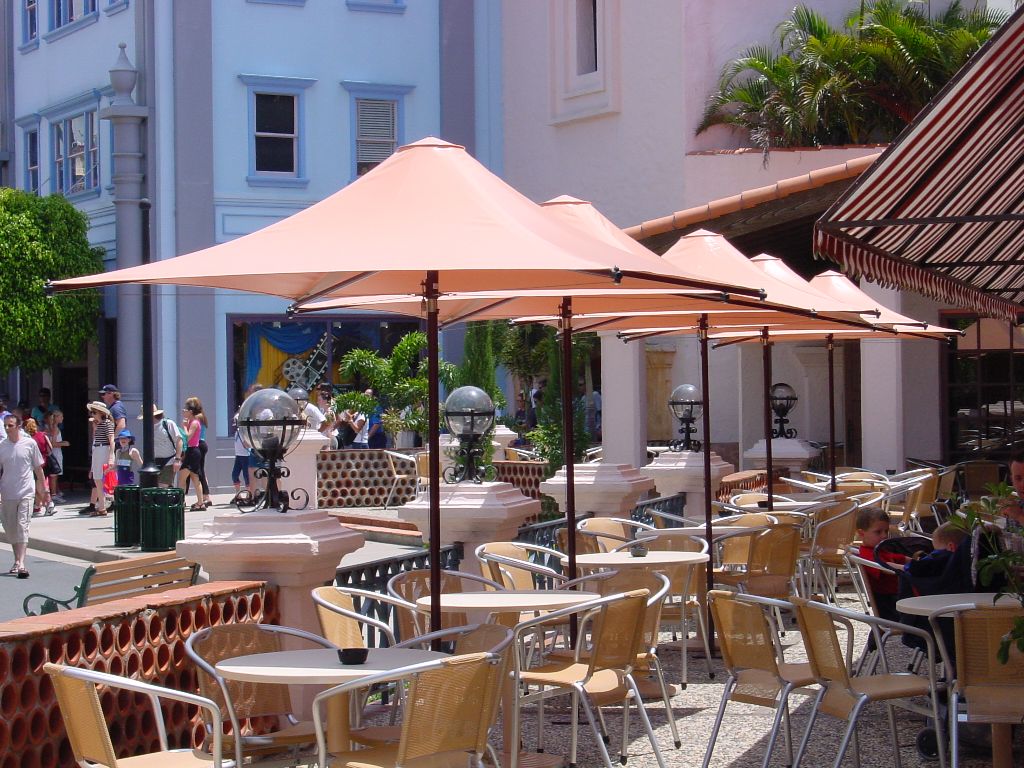

Taiyo Kogyo Column
Corona Profit Measures] Why “awnings,” eave tents for stores, increase restaurant sales.
2021.04.08

From the viewpoint of preventing the spread of the new coronavirus, the public has been urged to avoid the so-called “three densities” in all places and situations. This has greatly affected restaurants, shopping malls, and other business categories that were originally often densely populated, and sales per square meter have dropped dramatically due to “thinning out” operations that maintain a certain level of spacing between restaurants. Awnings” may save restaurants in difficult circumstances due to the Corona disaster.
What are awnings? What are the advantages of utilizing them? Why do they increase sales? We have compiled such details.
The contents are useful for managers of restaurant stores (street stores) and people involved in shopping malls. Please take a look.
What is an "awning" eave tent for stores?
If you are a restaurant owner, you may have heard the term “awning. Awning means “sunshade or shelter from rain,” and often refers to the eaves extending outward from the eaves of a street-front store, or the tent-like roof over a terrace. In Europe, eaves have a long history of being widely used for their functionality and beauty, and they also decorate the exterior of stores and serve as signboards.
Because they can make use of outdoor space, they are attracting increasing attention, especially in the recent Corona disaster.
Awning Types
There are several types of awnings in addition to the eaves-type awnings that extend from store windows. Below are four typical types of awnings.
Sunshade type
This is a relatively simple type of awning. The type that has a membrane material with dovetails, etc., and is used by tying it together with string is called a sunshade type. This type is often used to shade balconies and terraces.
wall-mounted ornament
The most common type of awning seen extending from the eaves or windows of street stores is called a wall-mounted awning. They are attached to the wall by a professional contractor, and most can be extended or retracted by turning a handle.
(spring) tension rod type
More often used in residences than in stores, the butt-rod awning is a type of awning. The awning is erected between the eaves and the ground, and a membrane awning is extended from the eaves. This type of awning does not require any construction work, making it easy to use.
stand-alone
An awning that stands like a tent rather than being attached to a wall is called a freestanding awning. This type of awning is often installed on the terrace of a restaurant or in outdoor spaces in shopping malls.
Four advantages of utilizing eave tents and awnings in restaurants
The installation of awnings in restaurants and shopping malls offers the following four advantages. We recommend that you consider the Corona Disaster in particular, as it offers significant advantages.
Effective use of space with sun and rain protection effects
The addition of a roof over the eaves or terrace space allows for a wider range of weather conditions to be handled. Awnings can create a comfortable space for users and make effective use of the space, even in the rain or summer sun.
In some cases, a "building application" is not required for construction or installation.
オーニングの種類や設置する方法によっては建物としての申請「建築申請」が不要な場合があります。増築をしたり屋根を付けたりすると一般的には店舗の面積が広くなることになるので「建ぺい率」などを気にする必要がありますが、一部のオーニングは仮設屋根として見なされるのでこの対象にならないことがあるのです。
煩雑な申請なしで店舗スペースを広げられるのは大きなメリットです。
Can be put away when not in use
There are many different types of awnings, all of which have the advantage of being able to be folded, shrunk, or stored away when not needed. One advantage of awnings is that they can be used flexibly, such as to control sunlight and adjust the comfort of a space, or to be deployed only when needed when using a road surface.
Possibility to increase sales
The use of awnings increases the effective area of a store. The larger the area, the easier it is to make sales. Especially in these days when the Corona disaster requires the avoidance of three-density, there is a limit to the space inside the store with “thinned out” seating, so by utilizing the outside space, you can increase the space that is safe for users and may compensate for sales.
Laws related to awnings
Although awnings have many advantages and are easy to install, the laws involved are not few and should be kept in mind as basic knowledge. The following is a brief summary of the four laws related to awnings.
- the Building Standards Act
- Road Traffic Law and Highway Law
- Fire Services Act
the Building Standards Act
The Building Standard Law is the law that defines the safety of buildings and the standards for land for the purpose of “protecting the lives, health, and property of the people.” It clarifies the rules for buildings, sites, facilities, structures, and uses. If an awning is a “building,” it is subject to the Building Standard Law, but if any of the following apply, it is considered “not a building.
- Simple roll up and eave out made of tents
- Tents for temporary use, such as camping or event tents
- Minor, open, and not used for dwelling, office, work, or assembly within its interior.
In other words, it can be understood that if it is easy to put in and out and is small in scale, it may not be subject to the restrictions of the Building Standard Law.
Road Traffic Law and Highway Law
The Road Traffic Law is the law that defines the rules that vehicles and pedestrians must follow on the road, with the aim of preventing danger and facilitating traffic. The Road Law, although similar in name, defines the types of roads and the rules for their management. These laws also set standards for the use of roads, so it is necessary to check the rules when awnings are used to overhang the property.
Fire Services Act
The Fire Service Law establishes various rules to protect the lives, bodies, and property of citizens from fire. It defines standards for management systems and structures. For example, in order to use awnings in areas designated as “disaster prevention zones,” you need to be aware of regulations such as the need to use fire-retardant fabrics.
One-stop shop for eave tent "awning" installations from Taiyo Kogyo.
If this is your first time installing an awning, or if researching the law is a hassle, you may think, “I don’t know where to go for help. Since awning installation requires knowledge of the law, from product selection to installation techniques, we recommend that you contact a business that has the knowledge and experience to help you. Taiyo Kogyo Corporation is a well-established membrane material company that has been in business for 100 years. It is a leading company in the field of membrane structures that has also worked on world-famous buildings such as the Tokyo Dome, and has a wealth of experience in tents and awnings. In addition to product sales, we offer a one-stop service that includes confirmation of various laws, necessary applications, installation, and after-sales care.
summary
The following is a summary of the potential for awnings to increase sales at restaurants and other businesses. If awnings are installed with the right knowledge, it may be possible to increase the amount of space that can be effectively utilized without having to apply for building permits. If you are a restaurant owner considering supplementing sales for the Corona Disaster, please consider installing awnings.
Related Articles
- TOP>
- Taiyo Kogyo Column>
- Corona Profit Measures] Why “awnings,” eave tents for stores, increase restaurant sales.








